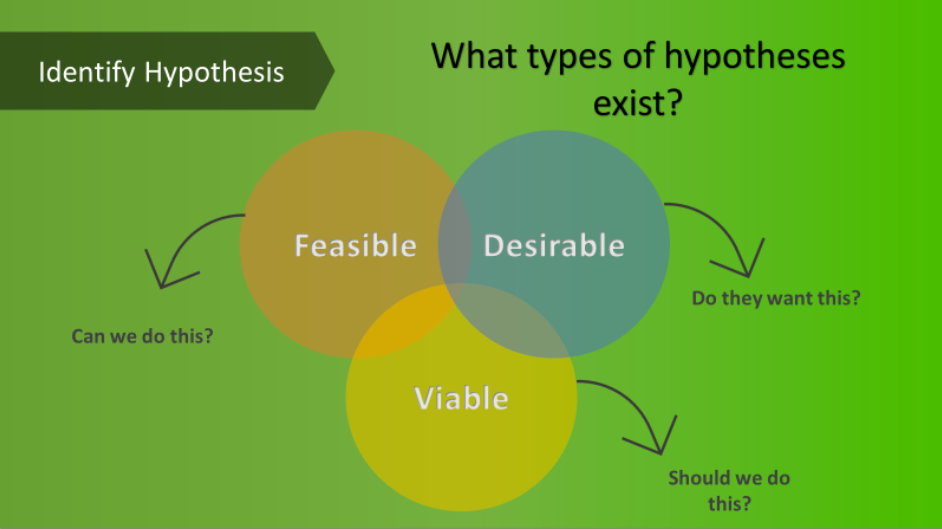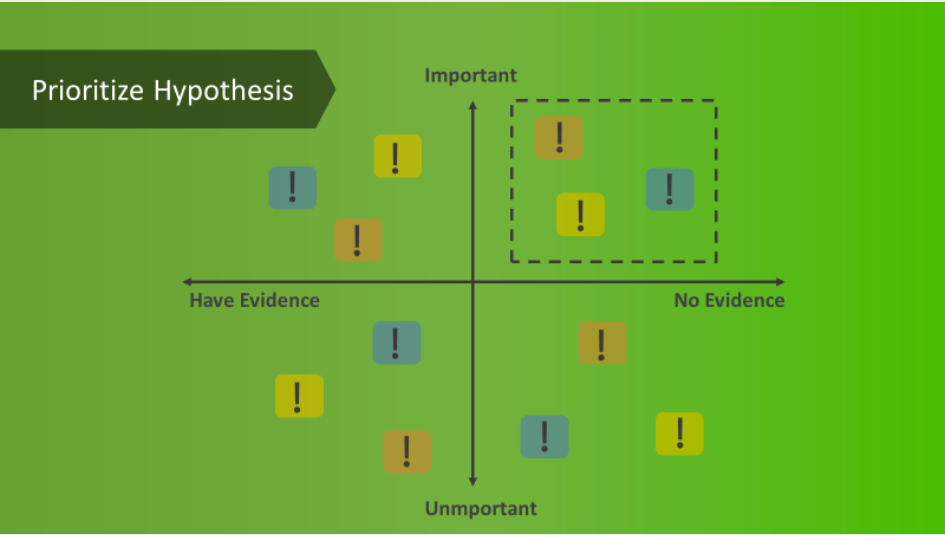Content begins here
Contenido de la página principal
Pulsa para colapsar
Hypothesis
The word hypothesis comes from the ancient Greek word hypothesis which means "assumption". Hypotheses are verifiable statements about what the researchers predict will be the outcome of a study. Once the topic is completed and approved, learners will be able to... Identify and prioritize hypothesis. In this lesson, we will learn what types of hypotheses exist and how to prioritize them.
When you are creating a hypothesis you need to have on mind that hypothesis needs to be:
- Testable - This means that hypothesis can be true or false but based on proof.
- Precise - This means that the hypothesis accurately describes who, when, and what you assume.
- Discrete - The hypothesis is discrete when it describes only one distinct.
Identify Hypothesis
What types of hypotheses exist?
Feasible - Can we do this?
Desirable - Do they want this?
Viable - Should we do this?
Desirability Hypothesis
You need to explore this first. While you are making Business Model Canvas and Value Proposition Canvas you must identify desirability hypotheses. Both parts of Value Proposition Canvas contain market risk, and the Business Model Canvas contains it in the value proposition, customer segment, customer relationship, and channels.
Feasibility Hypothesis
You need to explore this second. The Business Model Canvas has infrastructure risk in its segments such as Key Partners, Key Activities, and Key Resources.
Viability Hypothesis
This needs to be your third step. Business Model Canvas has financial risk in the Revenue Stream and Cost Structure. What is your next step?
Write down all your hypotheses on colorful sticky notes. Remember, the hypothesis should be:
- As specific as possible,
- Short and precise,
- Self-adhesive note.
Prioritize Hypothesis (Testing Business Ideas, 2019)
X-Axis: Evidence
On the x-axis, you should place all the hypotheses that can show how much evidence you have or do not have to substantiate or refute a particular hypothesis.
You should place the hypothesis on the left if you are able to present relevant evidence to support the hypothesis. You should put the hypothesis on the right if you have no evidence for it.
Y-Axis: Importance
On the y-axis and you need to set all your hypotheses in terms of importance. Put a hypothesis at the top if it is crucial to the success of your business idea.
Put the hypothesis to the bottom if it is not one of the first things you would come up with and test.
Conclusions
After these steps, we should focus on the upper right quadrant to find out which hypothesis you should test first.
Video and PDF presentationPulsa para colapsar
The following video explains the content of this lesson and shows some examples:
Video T3.L1. Hypothesis
Here you have the content of the video in pdf in case you need to use it in your classroom:
Lesson contents in PDFPulsa para colapsar
Here you have the contents of the lesson in PDF:



